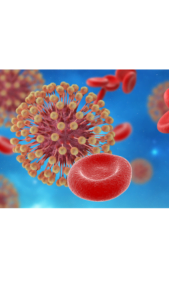Have you ever wondered if herpes simplex virus type 1 (HSV-1) can affect your eyes? Well, the answer is yes! HSV-1, commonly known as oral herpes or cold sores, can indeed have an impact on your eyes. Although the virus typically affects the mouth and lips, it can spread to the eyes through direct contact. In this article, we will explore the potential consequences of HSV-1 affecting the eyes and discuss the importance of early detection and treatment. So, let’s dive into the world of HSV-1 and its potential impact on our precious eyesight.

Overview of HSV-1
Definition of HSV-1
HSV-1, or Herpes Simplex Virus type 1, is a contagious virus that primarily affects the mouth and the face. It is a common infection that can cause cold sores or fever blisters around the lips and mouth. However, HSV-1 can also lead to infections in other parts of the body, including the eyes, which can have serious consequences if left untreated.
Prevalence
HSV-1 is extremely common worldwide, with an estimated 3.7 billion people under the age of 50 being infected. In certain regions, such as the Americas and Western Pacific, HSV-1 prevalence rates can be as high as 90%. While most people are infected with HSV-1 during childhood or adolescence, the virus can remain dormant in the body and reactivate periodically throughout a person’s life.
Modes of transmission
HSV-1 is typically transmitted through direct contact with an infected individual. This can occur through activities like kissing, sharing utensils or personal items, or engaging in oral sex. The virus can also spread to the eyes if infected secretions come into contact with them. It’s important to note that HSV-1 can be spread even when sores or symptoms are not present, making it possible for individuals to unknowingly transmit the virus.

Infection and Transmission to the Eyes
How HSV-1 can infect the eyes
When HSV-1 infects the eyes, it is known as ocular HSV-1. This can occur when the virus is manually transferred from an oral or facial cold sore to the eyes through touching or rubbing. Additionally, HSV-1 can be transmitted to the eyes through droplets from an infected person’s sneeze or cough.
Risk factors for eye infection
Certain factors can increase the risk of developing ocular HSV-1. These include a history of HSV-1 infection, compromised immune system, frequent exposure to cold sores or HSV-1 lesions, and a history of eye trauma or surgery. It’s important to be aware of these risk factors and take necessary precautions to minimize the chances of infection.

Get 51% Discount If You Order Now!
Common symptoms of ocular HSV-1
Ocular HSV-1 can present various symptoms, including redness, pain, swelling, sensitivity to light, blurred vision, and the appearance of small blisters on the eyelids or surface of the eye. If you experience any of these symptoms, it is essential to seek medical attention promptly to prevent further complications.
Types of Eye Infections Caused by HSV-1
Herpes Keratitis
Herpes Keratitis is the most common form of ocular HSV-1 infection and occurs when the virus infects the cornea, the clear front part of the eye. It can cause corneal ulcers, inflammation, and may lead to scarring if not treated promptly. This can potentially result in vision loss or impairment.
Herpes Conjunctivitis
Herpes Conjunctivitis refers to HSV-1 infection of the conjunctiva, the thin and transparent membrane that covers the white part of the eye and the inner surface of the eyelids. It can cause redness, tearing, discharge, and discomfort in the affected eye. Immediate treatment is crucial to prevent the infection from spreading and causing further complications.
Herpetic Uveitis
Herpetic Uveitis is a less common but potentially serious form of ocular HSV-1 infection. It affects the uvea, which includes the iris, ciliary body, and choroid. Herpetic uveitis can cause severe inflammation in the eyes, leading to pain, photophobia, blurred vision, and even permanent damage if not managed appropriately.
Clinical Presentation and Diagnosis
Examining the eyes for HSV-1 infection
When evaluating a potential ocular HSV-1 infection, healthcare professionals will examine the eyes for characteristic signs, including the presence of lesions, redness, swelling, and any abnormalities in the cornea or conjunctiva. A thorough examination is essential for accurate diagnosis and appropriate management.
Differential diagnosis of ocular HSV-1
The symptoms of ocular HSV-1 infection can be similar to those of other eye conditions, such as bacterial or viral conjunctivitis, corneal abrasion, or dry eye syndrome. To ensure an accurate diagnosis, healthcare professionals may perform various tests, which will be discussed in the next section.
Diagnostic tests
Diagnostic tests for ocular HSV-1 may include corneal staining with fluorescein, which can reveal the presence of ulcers or lesions, as well as swabbing or scraping of affected areas for laboratory testing. Additionally, blood tests may be conducted to detect the presence of HSV antibodies, which can indicate a recent or past infection.
Management and Treatment
Antiviral medications
The primary treatment for ocular HSV-1 infections involves antiviral medications. These medications help control viral replication, reduce inflammation, and prevent further complications. They can be administered orally or topically, depending on the severity of the infection.
Topical or oral administration
For less severe cases, antiviral eye drops or ointments may be prescribed. These are directly applied to the eyes to deliver the medication to the affected area. In more severe or recurrent cases, oral antiviral medications may be necessary to provide systemic treatment to control the infection.
Duration of treatment
The duration of treatment for ocular HSV-1 depends on the severity and type of infection. Mild cases may require treatment for a few days, while more severe or recurrent infections may require treatment for several weeks or even months. It is crucial to adhere to the prescribed treatment plan and follow-up with healthcare professionals as directed.
Complications and Long-Term Effects
Corneal scarring and vision loss
One of the significant complications of ocular HSV-1 infections is corneal scarring, which occurs when the infection damages the cornea. This scarring can affect vision and lead to permanent vision loss if left untreated or if scarring becomes severe. Timely diagnosis, treatment, and follow-up care are essential to minimizing the risk of corneal scarring.
Recurrence of ocular HSV-1
Once infected with HSV-1, the virus remains in the body for life. This means that recurrent ocular HSV-1 infections can occur, leading to repeated episodes of symptoms and potential complications. Close monitoring and ongoing management are necessary to address recurrences promptly and prevent long-term effects.
Persistent ocular inflammation
Some individuals may experience persistent inflammation in the eyes, known as chronic herpetic stromal keratitis, even after the initial infection has resolved. This can cause discomfort, blurred vision, and may require extended treatment to manage the inflammation effectively.
Prevention and Control Measures
Preventing primary HSV-1 infection
To reduce the risk of primary HSV-1 infection, it is essential to practice good hygiene habits. Avoid close contact with individuals experiencing active herpes lesions, avoid sharing personal items, and maintain proper hand hygiene by washing hands regularly with soap and water.
Reducing the risk of ocular HSV-1
To reduce the risk of ocular HSV-1, it is important to avoid touching or rubbing the eyes, as well as avoiding direct contact with someone experiencing an oral or facial herpes outbreak. Wearing protective eyewear in situations where eye trauma or injury may occur is also recommended.
Hand hygiene and avoiding contact with lesions
Proper hand hygiene is crucial in preventing the transmission of HSV-1. Washing hands frequently, especially before touching the face or eyes, can help reduce the risk of infection. Additionally, individuals with active oral or facial lesions should avoid touching the affected area to prevent spreading the virus to other parts of the body, including the eyes.
Special Considerations for High-Risk Individuals
Immunocompromised individuals
Immunocompromised individuals, such as those with HIV/AIDS, organ transplant recipients, or individuals on immunosuppressive medications, are at an increased risk of developing severe ocular HSV-1 infections. Close monitoring and early intervention are vital in managing and preventing complications in this high-risk population.
Pregnant women and newborns
Ocular HSV-1 infection poses a significant risk to pregnant women and newborns. Pregnant women with an active HSV-1 infection at the time of delivery can transmit the virus to their newborns, potentially leading to severe complications. Pregnant women should receive appropriate prenatal care and inform their healthcare providers of any history of HSV-1 infection to mitigate the risk of transmission.
Healthcare workers
Healthcare workers, especially those in close contact with patients or individuals known to have HSV-1 infections, should follow strict infection control measures. This includes wearing gloves and practicing proper hand hygiene, as well as wearing protective eyewear if there is a risk of exposure to the virus.
Effectiveness of Vaccination
Existing vaccines for HSV-1
Currently, there is no approved vaccine specifically targeting HSV-1. However, research and development efforts are underway to develop vaccines that can prevent primary or recurrent HSV-1 infections, including ocular infections. Various vaccine candidates are being evaluated in clinical trials to assess their safety and efficacy.
Efficacy and limitations
While vaccines show promise in preventing HSV-1 infections, their efficacy and long-term effectiveness need further investigation. It is also important to note that vaccines may not completely eliminate the risk of infection or ocular complications in individuals who have already been infected with HSV-1.
Potential for future vaccines
Continued research and development of vaccines for HSV-1 hold the potential to significantly reduce the incidence of new infections and the associated ocular complications. Ongoing clinical trials and scientific advancements in the field provide hope for the development of effective vaccines in the future.
Conclusion
Summary of ocular HSV-1
Ocular HSV-1 is a common and potentially serious infection that can lead to complications if not diagnosed and treated promptly. It can cause various eye infections, including herpes keratitis, herpes conjunctivitis, and herpetic uveitis. Timely medical intervention and adherence to treatment plans are crucial in managing and minimizing the risk of long-term effects.
Importance of early diagnosis and treatment
Early diagnosis of ocular HSV-1 is vital in preventing complications and minimizing the risk of permanent vision loss. If you experience any symptoms suggestive of ocular HSV-1, such as eye redness, pain, or blurred vision, it is important to seek medical attention promptly.
Continued research and prevention efforts
Research and development efforts for effective vaccines against HSV-1 are ongoing, offering hope for reducing the burden of this widespread infection, including its ocular complications. Continued research, education, and preventive measures are essential in minimizing the impact of ocular HSV-1 and improving the overall health and well-being of individuals affected by this infection.



